
Back in 2022 I posted a photo essay on the doors, windows, and street art of Palermo from our month stay. Has it really already been almost two years since then? Egad, I'm so, so far behind in my blog goals! There is much to share and never enough time to prepare. (I really, really don't understand people who complain about or have worries about being bored in retirement!) So, better late than never, here's a post about our 2020+ adventures in Palermo.
Palermo is right up there with all of the other famous cities of Italy, especially if you love history and architecture. It's a great place to visit!
While we were based in Palermo, we were working on exploring nearby towns as potential retirement places. As well, we made time to make a very special trip to Alcamo to meet John's Impellizzeri cousins and to explore this ancestral home town of three of John's grandparents. However, we did have a good amount of time to explore many of the jewels of Palermo during our extended stay.
Palermo is loaded with UNESCO sites. A cluster of nine sites appears on the UNESCO World List as Arab-Norman Palermo and the Cathedral Churches of Cefalú and Monreale (the latter two cathedrals in nearby cities). Dating from the Norman period in Sicily (mid 1100s), these locations represent the merging of Byzantine, Western, and Islamic cultures, leading to unique architectural and artistic designs. Culturally, it was a time of peaceful co-existence between different peoples. Imagine that!
The nine locations are: Norman Palace, Palatine Chapel, Zisa Palace, Church of San Giovanni degli Eremiti, Church of Santa Maria dell’Ammiraglio, Church of San Cataldo, the Admiral’s Bridge, and the cathedrals in Palermo, Monreale, and Cefalù. We had the opportunity to visit some of these during our stay in Palermo.
Palermo Cathedral
For me, Palermo Cathedral was all about the outside. The interior wasn't as engaging as the other cathedrals in the UNESCO cluster, probably because it does not have the beautiful mosaics and gold. An interesting feature of the interior is the Chapel of the Relics, which contains the remains of several important Sicilian saints. There are also significant tombs here, but there is an additional cost to view these (also to walk along the terraces). Since I didn't have a lot of time, I opted to just view the free portion of the cathedral. Maybe a deeper delve on a future visit?
Thirty second scan of the exterior and piazza.
Exterior details. The cathedral was built in the 1100s, with additions in subsequent centuries.
Interior details. S. Cristina 😁
Chapel of the Relics
Monreale Cathedral
To get to Monreale Cathedral, we took a HOHO bus shuttle. The short ride had some nice views, then we had about an hour to tour the cathedral before returning back to Palermo.
View of Palermo from Monreale
Friends
Lexie and Marcos, currently living in Palermo, took this night shot from Monreale. Pretty!
Monreale Cathedral Exteriors
Monreale Cathedral Interiors
Cefalù Cathedral
We haven't had luck with this cathedral. The first time we tried to visit, we missed the open hours because of a train delay. We returned a second time to visit while cousin Gerlyn was here last Fall. While we were able to go inside, the primary mosaic was under restoration, so we weren't able to see it. The cathedral was built between 1131 and 1240. Sharing a few photos of what we did see. (Cefalù is about an hour from Palermo. I'm including here because it is part of the UNESCO site.)
Church of Santa Maria dell’Ammiraglio (La Martorana)
This is one of three beautiful churches found on Piazza Bellini, and, as mentioned previously, is one of the sites making up the UNESCO Arab-Norman Palermo cluster. Its architectural style is Byzantine, Norman, and Baroque, and its groundbreaking was in 1143. The mosaics are incredible.
Church of San Cataldo
This church was built in the 12th century. It was repurposed as a post office in the 1700s and then restored to its original form in the late 1800s. Its red domes are particularly striking, both exterior and interior.
Chiesa Santa Caterina d'Alessandria
This cathedral is in the same square as the two UNESCO churches, and the back faces Praetorian Fountain. Although one can tour this church, for a fee, on our visit we were on the hunt for la dolceria del monastero of Chiesa di Santa Caterina for the highly recommended cannoli.
As fabulous as the cannolo was, the biscotti were even better!
The Cloister Garden
Did we go here more than once? We most certainly did!
Quattro Canti and Fontana Pretoria
The Four Corners, Piazza Vigliena, is the center of the historic portion of Palermo. Here you find four complementary building facades in the Baroque style. All of the facades share a theme at different levels. At the base are water features. At the next level are statues representing the Four Seasons, followed by a level of Spanish kings. The top level has the four original saints of Palermo. There's a lot going on!
Fontana Pretoria (
the Fountain of Shame) is right around the corner from the Corners. It's a massive fountain decorated with an assortment of statues, including mythological creatures, the Four Seasons, and Olympian gods. Apparently, the gates are sometimes open so that people can see it more closely, but it has been closed every time we passed by.
Enjoying a gelato near the Four Corners. Who needs a cone when you have a brioche!
Church of the Gesù (Casa Professa)
This is a must-see Palermo church near the area of the Mercato di Ballarò, another of Palermo's ancient street markets. A church established under the Jesuits, construction was initiated in 1590 and completed in 1636. My nickname for it is The Wedding Cake Church.
Just how many cherubs are there? I tried researching and could not find a number.
The marble is really beautiful. I liked how it was raised in many of the designs.
This cherub looks like he is riding Buckbeak!
Enjoying some pomegranate spremuta at Ballarò market.
Fresh octopus on offer.
Porta Felice and surrounding area
This city gate was not far from of our apartment. Construction on this gate began in the late 1500s and completed in 1637, after some work interruptions. There is a nice fountain nearby. Through the gate, you can find a long linear park on the waterfront. In the nearby neighborhood are some historical churches, as well as a city park called Villa Giulia.
Porta Felice and Fontana del Cavallo Marino
Letti di ceramici, part of the Foro Italico waterfront area. People were using them as beds, even with a ceramic pillow!
A humongous cart that we found on display while walking around. We think it was probably used for a religious festival / parade. Nice workmanship!
Chiesa Santa Teresa alla Kalsa, construction completed circa 1700. Ex Chiesa di San Mattia ai Crociferi, 17th century, is now a cultural and arts venue.
Chiesa Santa Maria della Pietà is the twin church of Santa Teresa alla Kalsa. Giacomo Amato was the architect for both of these churches.
Villa Giulia. This is a large urban park that has potential but we found disappointing. It didn't seem cared for, a shame.
Porta Nuova and Villa Bonnano
Porta Nuova is the main city gate to Palermo. One side faces the historical city center, while the other faces toward Monreale. It was completed in the late 1500s, but was rebuilt in the 1600s after a fire. Nearby are the lovely public gardens, Villa Bonnano.
Porta Nuova
View of the Gate from edge of Villa Bonanno.
An amusing sculpture in the gardens by artist Angelo Accardi. Lots of people making photos with this!
Teatro Massimo
I wanted to visit this theatre that has an auspicious appearance in Godfather III. My plan to lie on the steps and 'die' like Mary were not to be, since there was a cultural event going on. Nevertheless, I enjoyed seeing this magnificent building. Also on my bucket list to see the inside, specifically to attend an opera. By the time I realized there was an opera during our stay, the tickets were all sold out. Another time!
Gorgeous from every angle! I look forward to exploring the interior one day.
A minute from the cultural performance.
I lived on art, I lived on love. Culture is the soul of the people.
Nearby pasta lunch.
En route, we paused to enjoy the exteriors of Chiesa di Sant'Ignazio all'Olivella, c. 1600.
Capo Market and Chiesa Sant' Ippolito Martire
We visited this area twice to visit the church where John's 7th / 10th great-grandparents were married. On our first trip, a funeral was about to take place, so we could only take a brief look around. We returned later and had a chance to look at things more closely. John wrote a blog about his experience visiting this special spot, and information is there on the church's history, as well as on the history of Capo Market. If you'd like to explore further, you can find it here. Some additional photos from our return visit ....
It was mind-boggling to think about how some of these elements were present in 1631 when Nunzio and Onofria exchanged their vows!
Also in Capo Market area is the pretty Porta Carini. This gate was built in the late 1700s, and it replaced an original city gate from the 1300s! Its name comes from the fact that its road leads to a nearby town, Carini, which also happens to be one of John's ancestral hometowns going farther back in his tree.
We've not yet had a chance to visit Carini. Here John is standing in front of a statue at the central train station in Palermo. There are sections for different cities in Palermo province. The most recent ancestor from Carini is John's 4th great-grandfather (in the Benedetta Adamo line) Agostino Gambino. He was baptized in Carini 19 September 1764!
La Vuccirìa
Our apartment was in the neighborhood of this ancient market. John enjoyed popping down several times to try Palermo's famous street foods.
Fresh seafood fry.
Around the market.
Stigghiola is a popular street food at this market. None for me, thank you.
John is always on the hunt for
sfincione. Of the places he's tried it, the type in Palermo is most similar to that which his family made.
Chiesa di San Domenico
This church was in our neighborhood, and we enjoyed gazing at it, as well as the Colonna dell’Immacolata, as we passed by on daily tasks. We visited the interior twice. Many famous Sicilians are entombed here.
Chiesa exterior and the Colonna.
Chiesa Interiors
To me, this was the most interesting of the notable Sicilians entombed in this church. (If you aren't familiar with Falcone, see link below in next section.) Everyone who came in this church interacted with this grave - placing flowers, sign of the cross, etc. It was very touching to observe.
Marina
The marina was also near our apartment, so we often stopped to sit here when out and about on errands.
The marina accommodates boats large and small. Do you spot the cruise ship? If you're ever on a cruise with a Palermo stop, let us know. We'll come meet you.
There is a famous mural of
Falcone and Borsellino, two magistrates involved in Mafia trials, who were murdered in bombings. Near the marina is a sculpture, Monumento ai Caduti nella Lotta contro la Mafia, by artist Mario Pecoraino. This is a monument to those fallen in the fight again the Mafia.
Oratorio di Santa Cita
I discovered this church, notable for its Baroque stucco work, was not too far from our apartment, so we went to check it out. It was well worth the small entrance fee. The stucco is by artist Giacomo Serpotta and was carried out in the late 1600s. When visiting, I learned that this church is one of five sites in The Treasures of the Lodge, five architectural treasures in Palermo's historical center. Unfortunately, this was near the end of our stay, so we didn't get to explore any of the others. Another visit!
Palermo Revisited
We've returned to Palermo several times since that original stay in 2022. It's very easy to get to Palermo by train from Capo D'Orlando. Our trips have not been sightseeing, however, because it seems we are always there for business - like going to the airport - or on a recent trip for a medical appointment at the civic hospital.
The hospital complex had this cool mural about blood types. On this trip, we finally got to take a ride on a train from the newest fleet, Blues. This fleet is hybrid and has interesting features like temperature control based on the number of passengers. Nice ride!
It wasn't until the Blues train came out that we realized - DUH! - that the
train types are named after musical genres. We had ridden on the Pop and Jazz trains previously. Apparently, there are also Rock and Swing types, but I've never seen those. How fun and creative!
Whenever I travel through Palermo Centrale, I like to pop in the cafe and have a Nutella espresso. Thank you to whoever thought of this masterpiece!
When cousin Gerlyn visited last Fall (another post I've yet to write!), we took a short trip to Palermo together before she departed back home from Palermo airport.
On the train to Palermo. This is the Jazz train.
On this trip, I got to visit the one place that was on my list that I didn't get to in 2022 - the Norman Palace and Palatine Chapel from the UNESCO 9! Il Palazzo dei Normanni has been the seat and residence of several rulers, and it is the current seat of Sicilian Regional Assembly. It is the oldest royal residence in all of Europe!
Norman Palace
The sign explains the site's significance better than I could ever summarize!
Il Palazzo dei Normanni is very grand. It is virtually impossible to get a full shot of the exterior. It faces a lovely public garden. Below are some shots of the exterior.

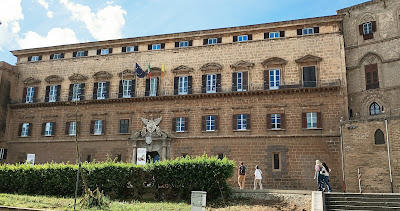



Moving to the inside, there was so much to explore. We barely scratched the surface and could definitely return!
The grand courtyard is from the 17th century. You may have seen it in film or television shows. We most recently spotted it in The Lions of Sicily.
Hercule's room (Sala d'Ercole) is the meeting place of the Regional Assembly. The paintings, completed in the 19th century by Guiseppe Velasco) depict the Greek myth of Hercules.
The Chinese Hall served as an anteroom for the Royal Apartments. Circa 1835 by Giovanni Patricolo.
Sala di Ruggero and Sala dei Venti. The mosaics were gorgeous.
Wooden ceiling from 17th century.
A lovely decorative panel.
Pisan Tower, throne room of Norman and Swabian kings.
Palatine Chapel
Many beautiful spaces in the Palace, but the jewel is the Palatine Chapel. It was commissioned in 1132 and contains Byzantine, Arabic, and Norman elements. There is so much to take in, it's a bit overwhelming.
Entrance. Number of visitors is controlled, which enhances one's enjoyment.


The central altar
Surrounding areas
Muqarnas ceiling
Other ceiling details
Additional details
I enjoyed trying to spot the Biblical stories in the designs. And, I found my saint! My
Onomastico is 24 July. I love Italy - an extra celebration day!
To finish off our visit to the Palace, we took a spin through - and a rest in - the Palace Gardens.
Lovely! Do you know the meaning of the
Pigna Siciliana? I took a photo of this one because it was in my favorite color.
The garden had a beautiful Moreton bay fig, which our Santa Barbara friends should especially appreciate.
After visiting the Palace, we returned to a nearby favorite fast food place for lunch. Sfrigola sells all types of arancine (Palermo spelling!), as well as my favorite soda. Yum!
While the Norman Palace and Palatine Chapel was our primary target, we also had time to wander around by foot. In addition, we bought HOHO bus tickets so that GG could get an overview of Palermo in our limited time there. Here's a mini photo essay from our time about ...
There is so much to enjoy - large and small - in Palermo.
During our walkabout, we took Gerlyn to see the famous Quattro Canti, Fontana Pretoria, and the exteriors of Chiesa di San Cataldo and Chiesa Santa Maria dell’Ammiraglio. Of course, nearby, we had to return to the number one place we recommend to anyone visiting Palermo - I segreti del chiostro! We also popped into Chiesa del Gesù di Casa Professa.
A minute at the Four Corners, with a busker.
Piazza Pretoria with the "Fountain of Shame." The dome of Chiesa Santa Caterina d'Alessandria is visible in the background.
Chiesa di San Cataldo and Chiesa Santa Maria dell’Ammiraglio
As mentioned previously, we've not yet toured the interior of Chiesa Santa Caterina d'Alessandria. However, when we've been to the old Cloister to get the sweets, we've had glimpses of the inside.
I always thought I didn't like cannoli, until I tried these!
Biscotti, a little worse for wear after carrying them in my purse. But, still delicious!
A couple more shots of where you get to enjoy your cannolo, the Cloister garden.
Last but not least, a re-visit to Chiesa del Gesù di Casa Professa. There is so much detail in this church, you really can visit it multiple times!
Well, I hope you enjoyed my virtual tour of Palermo. Maybe we'll see you there some day?!































.jpg)


.jpg)


















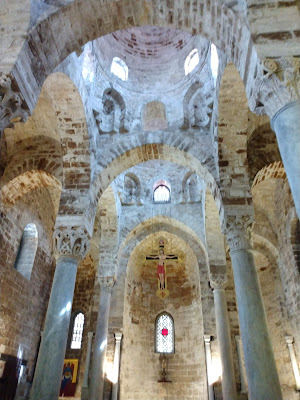




.jpg)



















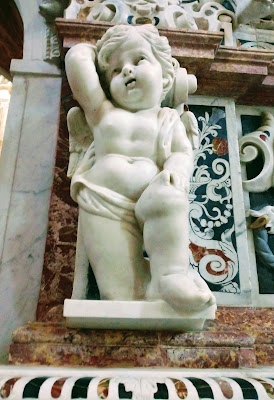











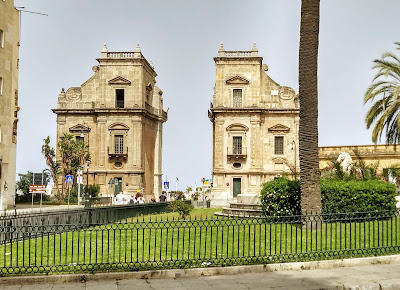


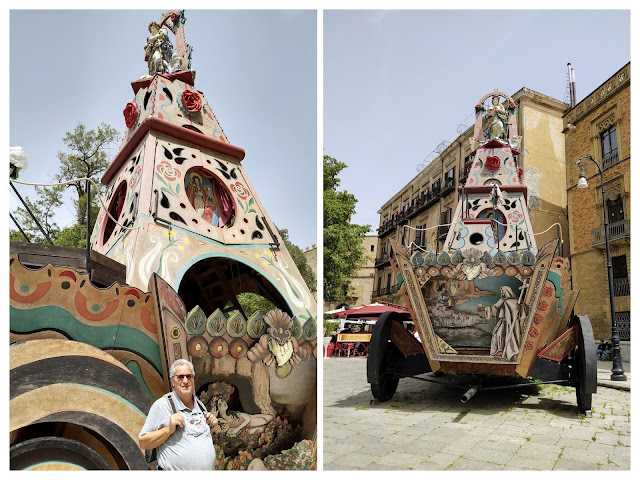





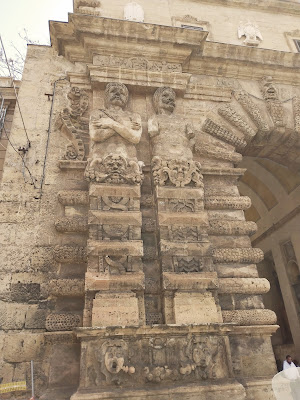







.jpg)




















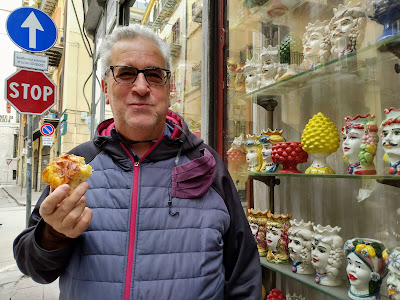


























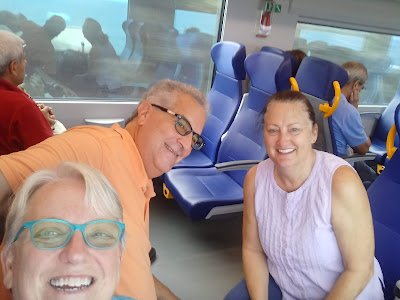




















































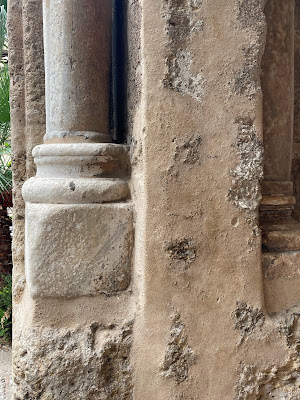














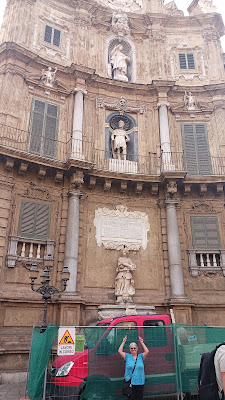
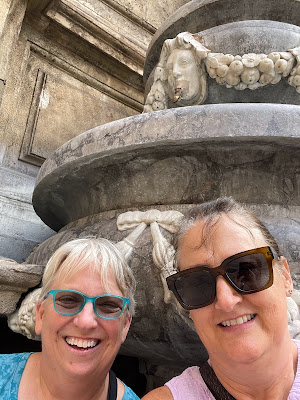






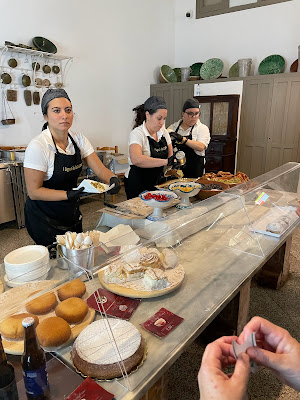












I enjoyed the "Sicily is not Italy" sign, which Italy would be glad, and frequently does, remind Sicilians.
ReplyDeleteI've encountered several Sicilians who, happily, feel this way. We certainly encountered, sadly, that bias when we visited Firenze.
DeleteThe pictures are wonderful, I can’t wait to visit Sicily. Hopefully late this year. I have to try the cannoli. You said they are the best. Rob P.
ReplyDeleteHope to see you soon!
Delete